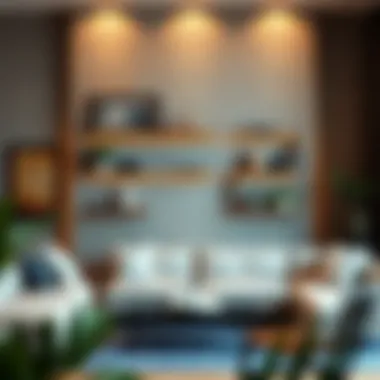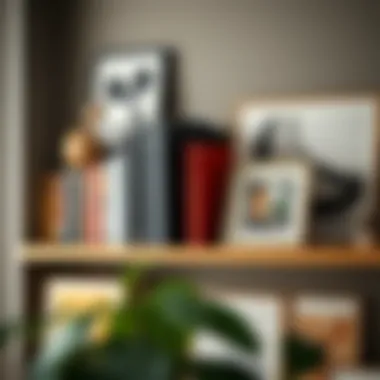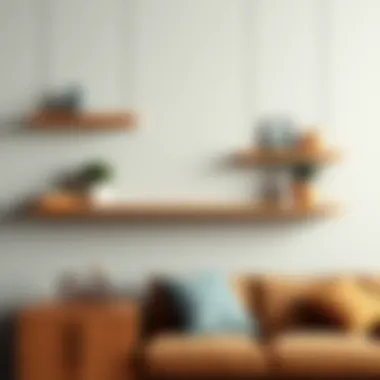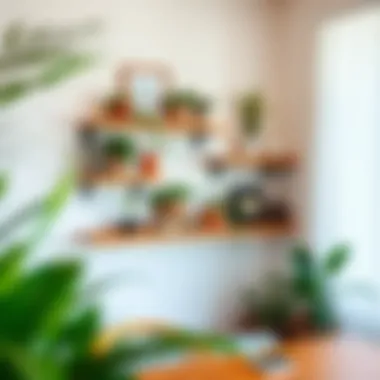Floating Shelves: Design and Functionality Guide


Intro
Floating shelves have taken interior design by storm, becoming a staple in many homes. Their sleek appearance and multifunctionality cater to both aesthetic and practical needs. But why focus on just two floating shelves? By narrowing the scope, we can uncover the nuances that influence design choices, enhance usability, and create memorable styles. This guide aims to dissect every angle, from current design trends to material selection and maintenance, ensuring you have a comprehensive resource at your fingertips.
As we delve deeper, it becomes essential to understand how floating shelves can transform a space. Homeowners, designers, retailers, and DIY enthusiasts alike can find value in learning how to select, style, and care for these versatile fixtures. Ready to embark on an exploration of two floating shelves? Let's dive in.
Preamble to Floating Shelves
Floating shelves have shifted from mere storage solutions to elegant design elements gracing contemporary interiors. These shelves, anchored securely to walls without visible brackets, provide a polished appearance that can enhance any living space. For homeowners and designers alike, floating shelves present a unique fusion of aesthetic appeal and practical utility, making them a versatile addition to various settings.
Why focus on floating shelves? The answer lies in their ability to cater to both functionality and style. Homeowners can optimize space, creating balance and organization without compromising on design. For DIY enthusiasts, the project of crafting or installing floating shelves can be a rewarding task, allowing for personal expression through materials and arrangements. It’s not just about the shelf itself; it’s how it accommodates and uplifts the living space.
Defining Floating Shelves
Floating shelves are essentially wall-mounted shelves that appear to 'float' without any visible means of support. They can be made from different materials like wood, metal, or glass, and their seamless integration into walls lends an uncluttered look. There’s no denying the allure of how they can transform a wall into a canvas for storage and display.
A hallmark of contemporary home design, floating shelves come in various lengths, depths, and finishes, allowing them to blend effortlessly into existing décor. They differ from traditional shelving units in that they are space-saving and often emphasize minimalism. This makes them especially appealing in smaller rooms where maximizing space is paramount.
The Concept of Aesthetics and Utility
Floating shelves walk the fine line between art and utility. On one hand, their sleek lines and chic presentation enhance a room’s aesthetic; on the other, they offer substantial functionality. The beauty of these shelves lies in their versatility — whether displaying a curated collection of books or housing cherished photographs, they adapt to their environment while staying unobtrusive.
- Aesthetics: The visual appeal of floating shelves cannot be undervalued. They can serve as focal points in a room, guiding the eye and enhancing the overall design.
- Utility: Beyond decoration, the practicality of floating shelves cannot be ignored. They provide storage for various items, making homes organized and efficient.
Simply put, floating shelves represent an elegant solution to the age-old dilemma of balancing space and style.
Understanding the Design Variability
When discussing floating shelves, it’s essential to grasp the nuances of their design variability. This topic is the cornerstone of selecting the right shelves for your space. Design variability emphasizes how different styles, materials, and finishes can significantly affect aesthetics and functionality. Each design choice not only serves a purpose but also influences the overall vibe of a room. By understanding these aspects, homeowners and designers can make educated decisions that align with their vision.
Styles of Floating Shelves
Contemporary Designs
Contemporary designs primarily focus on minimalism and integration with modern architectures. Sleek lines and a lack of visible hardware are hallmark traits, making these shelves appealing for contemporary settings. The contribution of this style to functionality cannot be overstated. Their simplicity often allows for various decorative elements to be showcased without overwhelming the space. The key characteristic here is how they blend seamlessly into backgrounds, allowing the display items, such as books or art, to take center stage.
Unique to contemporary designs is their ability to involve materials like metal and glass, facilitating a striking visual. Their advantages lie in their ability to create a clean, uncluttered look, perfect for modern homes. However, one disadvantage might be their minimal utility, as they may not be ideal for displaying heavier items due to structural considerations.
Vintage Inspirations
The charm of vintage inspirations is hard to resist. This style draws from various epochs, often marked by intricate detailing and warmth. Vintage-inspired floating shelves serve as a narrative window, presenting nostalgia and character. The unique aspect of these designs lies in their historic elements; think ornate carvings or distressed finishes, which imbue a sense of story into your decor.
Their benefit lies in enhancing the cozy, homey feel of a space, appealing particularly to those who value character over minimalism. However, this style can sometimes seem out of place in ultra-modern spaces, which can limit its versatility. Thus, while vintage designs can charm, they may not suit every aesthetic vision.
Rustic Charm
Rustic charm showcases the beauty of nature and raw materials. This design style often incorporates reclaimed wood, giving a unique texture and warmth. One of the major contributions of rustic floating shelves is their ability to bring a touch of the outdoors in. They often feature an unpolished finish that resonates with individuals who appreciate a more organic aesthetic.
The defining characteristic of rustic charm is its unpredictability; no two shelves look quite the same. This individuality is a significant advantage, as it adds a bespoke quality to your decor. However, this can also be a downside, as the rough finish might not appeal to those seeking a more refined look. In a nutshell, rustic floating shelves are perfect for creating cozy spaces but can clash with modern minimalism.
Color Choices and Finishes
Neutral Tones
Neutral tones present a versatile option, often serving as a backdrop for more colorful decor. The understated nature of shades like beige, gray, and white ensures that the shelves fit seamlessly into various design schemes. Their contribution to the overall goal of floating shelves is significant; they create an open and airy feel, essential for smaller spaces.
The key characteristic of neutral tones is their ability to enhance light and space, making rooms appear larger and more welcoming. An advantage here is the sheer adaptability of these shades—they effortlessly blend with other colors and textures. However, a potential downside could be their tendency to appear dull if not paired with lively accents.


Bold Colors
Bold colors allow for a striking statement that can invigorate a space. Choosing floating shelves in vivid shades—like deep blue or rich red—can transform an ordinary wall into an eye-catching canvas. This particular aspect contributes to creating focal points that attract attention and can express personal style loudly.
The main draw of bold colors is their energy; they can serve to uplift the mood of a room. They provide unique flair that screams individuality, appealing to creative sorts. However, one must tread carefully, for selecting striking colors without consideration of the surroundings can lead to a disjointed look, where the shelves overpower rather than complement existing decor.
Natural Wood Finishes
Natural wood finishes highlight the beauty of the material itself. These finishes preserve the inherent grain and texture of wood, often showcasing its variances beautifully. This approach to floating shelves emphasizes authenticity and craftsmanship. By opting for natural wood, a connection to nature is emphasized, which can resonate with homeowners who are eco-conscious or prefer organic aesthetics.
The unique feature of natural wood finishes is their timeless appeal. They pair gracefully with various styles—ranging from modern to traditional. Their ability to bring warmth into a room is also an advantage, creating an inviting atmosphere. However, one consideration is that natural wood may require more upkeep compared to synthetic finishes, which could deter some homeowners. Ultimately, natural wood finishes offer a blend of beauty and authenticity that many find irresistible.
Selecting the Right Materials
Choosing the right materials is as crucial as picking the perfect frames for your favorite photos; it's where aesthetics meet function. When it comes to floating shelves, the material influences both the look and longevity of your investment. A well-selected material not only contributes to the visual appeal, but it also ensures that the shelves can handle their intended purpose without buckling under pressure or losing their charm over time. From cozy rustic woods to sleek modern metals, each choice has its own unique characteristics that may sway your decision. Understanding these attributes helps you make a discerning choice.
Common Materials for Floating Shelves
Wood
Wood is often hailed as the classic choice for floating shelves and for good reason. Its natural grain patterns and warm hues lend an inviting atmosphere to any room. Softwoods like pine are commonly used because they are lightweight and easier to work with. On the other hand, hardwoods such as oak or walnut offer durability and a touch of elegance. One key feature of wood is its versatility; it can be stained or painted to match almost any décor. However, it’s not all sunshine and rainbows. Wood can expand and contract with humidity changes, which may lead to warping in certain environments. Still, thoughtful selection and treatment can mitigate these downsides, making wood a beloved choice among many homeowners and designers.
Metal
Metal provides an entirely different aesthetic and functional angle. It can introduce a modern, industrial flair that's hard to beat. Common types include steel and aluminum, both known for their strength and resilience. A standout trait of metal is its ability to withstand significant weight—it can support hefty books or decorative artifacts without causing worry. However, the cold hard feel may not suit all settings. Additionally, rust and corrosion can become issues if the metal is not properly treated or maintained, particularly in humid environments. That aside, metal's sleek lines and minimalist vibe often appeal to a contemporary crowd seeking something strikingly different.
Glass
If you want to create an air of lightness and transparency, glass shelves might just do the trick. These surfaces may seem delicate but can be surprisingly strong, especially tempered glass. The transparent quality of glass makes it ideal for showcasing decorative items and artwork. One significant advantage is that glass doesn’t compete with or detract from the surrounding decor; instead it amplifies it. However, it’s important to consider that dust tends to accumulate more visibly on glass surfaces, which might demand more frequent cleaning. Additionally, despite its chic appearance, the breakability of glass gives some homeowners pause. Overall, glass is a fantastic choice for those looking to achieve that open, airy feel in a room.
Sustainability in Material Choices
In today's world, making sustainable choices is more than just a trend; it's becoming a necessity. When selecting materials for floating shelves, it's important to look for options that not only enhance your interior design but also comply with environmental considerations. Options like reclaimed wood or sustainably sourced materials can offer both beauty and a smaller carbon footprint. Choosing materials that are manufactured responsibly can also help balance your aesthetic needs with ethical ones.
"A well-made shelf is not just a piece of furniture; it's an investment in comfort and style that lasts."
Being aware of where your materials come from encourages responsible consumption. A little research goes a long way in making choices that align better with a sustainable lifestyle. Consider checking out resources from organizations focused on sustainable practices, such as the Forest Stewardship Council (fsc.org) or local recycling facilities looking to turn discarded materials into new products.
The Functional Benefits of Floating Shelves
Floating shelves are not merely decorative accents in a home; they serve practical purposes that enhance both space and organization. Understanding the functional benefits is key for homeowners, designers, and even DIY enthusiasts looking to optimize their living environments. The appeal of floating shelves lies in their ability to marry aesthetics with utility, transforming wherever they are installed into more organized and visually pleasing spaces.
Optimizing Space Utilization
One of the primary advantages of floating shelves is their role in optimizing space utilization. In smaller homes or rooms, every square foot counts, and traditional furniture can eat up valuable floor space. Floating shelves resolve this problem by freeing up floor area, allowing for more efficient use of the room.
When thinking about room layout, it’s essential to consider vertical space. Installing two floating shelves can create a striking visual element while making practical use of typically under-utilized wall space. In kitchens, they can hold spices and cookbooks, while in living rooms, they can display art and mementos without taking up any floor space. This optimization leads to a feeling of openness and greater functionality, which is particularly impactful in urban living situations where space is at a premium.
Enhancing Organizational Capacity
Floating shelves also improve organizational capacity, making it easier to maintain order in any room. Their design allows for a myriad of organization options, catering to both display and storage needs.
Display Options
Display options on floating shelves provide homeowners an opportunity to showcase their personality through decor. They act as a gallery for personal artifacts, decorative ceramics, or family photos, seamlessly integrating style with function. The beauty of this approach lies in its adaptability. You can change up the displayed items seasonally or with changing trends, keeping the space fresh and inviting.
What makes display options particularly appealing is the ability to mix functionality with artistry. Rather than using shelves solely for storing items, you can create a vibrant narrative through well-chosen decorative pieces. This practice not only looks good but can also evoke conversation and interest among visitors, highlighting personal stories and tastes. However, care should be taken to avoid overcrowding. A cluttered shelf can detract from its intended purpose, which is sometimes to create a focal point instead of becoming a chaotic jumble.
Storage Solutions


Storage solutions through floating shelves provide a clever way to declutter while still keeping essentials close at hand. Housing books, baskets or utility items on these shelves offers a tidy appearance in the room without sacrificing quick access to everyday items.
The key benefit of these storage solutions is the versatility they offer. For instance, in a bathroom, you might use a pair of floating shelves to hold towels and toiletries, which can completely transform the usual appearance of cramped bathroom spaces. Alternatively, in a home office, they can keep files and supplies organized, thus fostering a more productive environment.
Like display options, storage solutions need balance. Overloading shelves can undermine the space’s aesthetics, and organizing items by category can enhance both functionality and simple navigation.
"Floating shelves may seem simple but their impact on space management and aesthetics can be profound."
The combination of display and storage functions positions floating shelves as a sensible choice. Beyond just providing a surface, they optimize space, enhance organization, and make a lasting impression in your home. By thoughtfully incorporating floating shelves, one can create environments that feel both spacious and personalized.
Installation Process for Floating Shelves
Incorporating floating shelves into a space isn’t just about aesthetics; it’s also about how well they're installed. A poorly installed shelf can lead to disappointment and even safety issues. When done right, the installation process enhances the visual appeal while ensuring functionality and stability. The right positioning can transform even an ordinary wall into a striking focal point in your room. Therefore, understanding the installation intricacies is key to maximizing the benefits of floating shelves.
Essential Tools and Materials Required
Before starting the installation, gathering the right tools and materials is essential. Here’s a list of what you’ll need:
- Drill: For creating holes in the wall where the brackets will go.
- Level: To ensure your shelf sits perfectly horizontal; no one wants a wobbly display!
- Stud Finder: This helps locate the wall studs for secure anchoring.
- Anchors and Screws: Essential for securing the brackets if you can’t hit a stud directly.
- Tape Measure: For precise measurements to mark where the shelves will go.
- Pencil: For marking positions clearly without permanent impact.
With these tools at your disposal, you’re already halfway to successfully installing your floating shelves. It’s often the simple things that make the biggest difference.
Step-by-Step Installation Guide
Now, let’s roll up your sleeves and dive into the step-by-step process to install those floating shelves securely.
- Determine Placement: Decide on the height and spacing of your shelves. Consider what you’ll display and the overall room balance.
- Mark the Wall: Using a tape measure and pencil, mark where the brackets will go. Make sure to check for level all along.
- Find the Studs: Use the stud finder to identify the placement of the wall studs. Ideally, you’ll want to attach the brackets directly into the studs for added support.
- Drill Holes: Once you’ve identified the studs, drill holes at the marked locations. If you are using wall anchors, make sure to follow the anchor’s instructions for hole size.
- Install Anchors/Screws: Insert wall anchors if you’re not drilling directly into studs. For other locations, secure the screws into the drilled holes.
- Attach Brackets: Align the brackets with the holes, ensuring they are level. Fasten them into place.
- Mount Shelves: Finally, carefully place the shelves onto the brackets. Check to see if they are stable and level.
"A good installation sets the stage for a shelf that not only enhances the decor but stands the test of time."
Completing these steps with meticulous attention ensures a solid installation. This process not only guarantees the longevity of your floating shelves but also provides peace of mind as you display your prized possessions. With the right tools and follow-through, your floating shelves can be a seamless blend of form and function.
Styling Techniques for Floating Shelves
When it comes to decorating a home, floating shelves offer endless possibilities for style and function. Beyond simple storage, these shelves can transform a wall into a focal point. The art of styling floating shelves is not just about placing items haphazardly; it requires some thought and creativity. Arranging decorative items and creating visual balance can enhance the aesthetic appeal of your space.
Arranging Decorative Items
Arranging decorative items on floating shelves can be likened to making a fine recipe; each element has its place and purpose. Start by choosing a theme that resonates with your overall home decor. For instance, if you lean towards a minimalist style, opt for a few standout pieces like a sleek vase or an artful sculpture. In contrast, a collection of books, photos, and quirky finds might suit a more eclectic vibe.
Here’s a straightforward approach for a harmonious arrangement:
- Layering: Place items in layers to create depth. Lean a framed photo against the wall and place a small potted plant in front of it. This method adds interest and dimension to the display.
- Grouping: Use the rule of three when selecting items to showcase. Grouping items in threes tends to create visual intrigue, as it guides the eye naturally from one piece to the next.
- Height Variation: Mix items of various heights. Tall plants paired with shorter decorative objects prevent the arrangement from appearing flat. This method ensures there’s always something to catch the eye.
"A well-styled shelf is a canvas where personal stories are told—each item holds meaning, inviting onlookers into a glimpse of your life."
Creating Visual Balance
Visual balance is critical when styling floating shelves. It involves distributing visual weight evenly across the display to achieve a sense of harmony. However, balance goes beyond merely having similar-sized objects.
Consider these pointers to create that perfect visual equilibrium:
- Symmetry vs. Asymmetry: Decide whether you want a symmetrical arrangement, where items mirror each other on both sides, or an asymmetrical one, which offers a more dynamic look. Symmetry can be calming, ideal for formal settings, while asymmetry can add energy to the shelf, suitable for casual areas.
- Color Coordination: Incorporate colors that complement each other. Using a consistent color palette not only helps create unity but also enhances the overall aesthetic. For instance, if you have pastel objects, pairing them with white shelves will elevate the display's lightness.
- Negative Space: Don’t forget about negative space—the areas without items. Intentionally leaving some room empty allows the individual pieces to stand out, creating a visual breather in your arrangement.
Incorporating these styling techniques will help you make the most out of your floating shelves, ultimately enhancing both their beauty and functionality. By taking the time to arrange items thoughtfully and create visual balance, you will not only beautify your space but also reflect your personal touch.
Maintenance and Care
When it comes to floating shelves, appearance and functionality go hand-in-hand. However, without proper maintenance and care, even the most beautifully designed shelves can start to look dull or deteriorate over time. Understanding how to care for your floating shelves not only preserves their aesthetics but also ensures their longevity, allowing them to continue serving their purpose effectively.


The significance of maintenance lies in the combination of daily use and environmental factors that can affect the materials your shelves are made from. Dust can settle on surfaces, moisture can warp wood, and the weight of decorative items can strain structural integrity. Taking the time to care for these shelves is an investment in your space’s appeal and functionality.
Routine Cleaning Practices
Establishing a regular cleaning regimen is vital for floating shelves. A clean shelf not only looks more appealing but also prevents any long-term damage that dust or grime might cause. Here are some practical tips:
- Use a soft cloth or microfiber cloth: Avoid rough fabrics that could scratch the surface. A gentle cloth eliminates dust without causing harm.
- Dampen when necessary: For wooden shelves, a slightly damp cloth combined with a mild soap solution keeps surfaces clean. Make sure to wring out excess water—too much can warp the wood.
- A periodic deep-clean: Every few months, consider a deeper clean. This includes checking for any built-up grime or potential mold, particularly in humid environments.
- Avoid harsh chemicals: Chemical cleaners can damage finishes and leave residues that attract more dirt. Stick to natural solutions.
"Regular cleaning not only enhances visual appeal but also extends the life of your shelves by preventing compound issues like rot or rust."
Tips for Longevity
Ensuring that your floating shelves withstand the test of time involves more than just cleaning. Here are some longevity tips to consider:
- Mind the weight limit: Always verify the weight capacity. Overloading can lead to bending or breakage. Check the specifications of your brackets or shelf materials regularly.
- Humidity control: If your shelves are in a humid area, it’s wise to run a dehumidifier or ensure good ventilation. This minimizes the chance of wood warping or metal rusting.
- Reinforcement: Depending on the installation, consider using professional services for the reinforcement of heavier items. Sometimes, it’s worth engaging an expert to ensure everything is securely fastened.
- Use coasters or trays: For items that might leak (think plants or drinks), using coasters or trays prevents spills from damaging the surfaces. This simple act goes a long way in guarding against stains.
- Inspection: Regularly inspect for any signs of wear - from chips in paint to rust spots. Early detection can save you a headache down the line.
By integrating these maintenance and care practices into your routine, you can ensure your floating shelves not only remain stylish but also serve their functional purpose efficiently over the years. This diligence solidifies their position in your living space as both practical and decorative elements of your décor.
Common Issues and Solutions
When it comes to floating shelves, the allure lies in their sleek appearance and versatility. However, common issues can pop up, turning what should be a stylish feature into an unwanted headache. Addressing these issues is crucial to maintaining both functionality and aesthetics.
Handling Weight Capacity Concerns
One of the most pressing topics for floating shelves is weight capacity. Many homeowners may find themselves wrestling with the agents of physics if they don’t pay close attention to this vital detail. Understanding the weight limits of your shelves prevents a messy and potentially dangerous collapse. Consider the material and design you choose, which can significantly influence how much load these shelves can bear.
When selecting floating shelves, pay attention to:
- Material Strength: Solid wood typically supports more weight than particle board or thin metal.
- Shelf Depth: A deeper shelf can distribute weight more effectively, making it less likely to bow or break under stress.
- Installation Method: Shelves anchored into wall studs tend to carry a higher load than those fixed to drywall alone.
It’s important to know the ideal items to place on your floating shelves—books, decorative items, and plants can work well, but oversized figurines or heavy picture frames may push the limits of safety. Therefore, a reasonable rule of thumb is to avoid exceeding 20-30 pounds per shelf, depending on the factors mentioned. This way, you won’t find yourself in a precarious situation down the line.
"Choosing the right floating shelf is not just about aesthetics; it’s also about knowing what you can safely display on it."
Addressing Installation Flaws
Installation flaws can turn the dream of a perfectly balanced floating shelf into a less-than-stellar reality. Whether they sag in the middle or wobble when leaned against, these imperfections can rob an entire room of its appeal. To prevent issues from the outset, the installation process should be tackled with care and attention.
Things to consider during installation:
- Proper Measurements: Always measure twice to ensure accurate placement. This can prevent a lot of headaches later on.
- Leveling Tools: Use a level to guarantee that your shelves are straight. An uneven shelf will look awkward and potentially damage whatever you place on it.
- Wall Types: Different wall types (like drywall or concrete) may require specific anchors. Using the wrong one can lead to failure. For instance, toggle bolts are great for drywall, while concrete walls need specific masonry anchors.
To address previously made installation errors, there are a few DIY fixes such as:
- Realigning the shelf carefully to ensure it’s level.
- Using additional wall braces if sagging is a concern.
- If you’re really in a bind, it may be worth calling in a professional to reassess the installation.
Mistakes in installation are not just an inconvenience; they can impact the overall safety of your home. Attention to detail in this stage is critical to ensure your floating shelves are as reliable as they are stylish.
Culmination: The Versatility of a Set of Two Floating Shelves
In the realm of interior design, floating shelves represent a unique fusion of aesthetic appeal and practical utility. As we’ve explored, a set of two floating shelves not only adds to the visual intrigue of a space but also serves vital organizational and display purposes. When strategically placed, they can create a sense of openness while providing essential storage solutions.
Benefits of Floating Shelves
The versatility of two floating shelves can be seen in various contexts:
- Space Optimization: Whether in a cozy studio or a spacious living room, these shelves can elevate the decor without overwhelming the environment. They allow for effective use of vertical space, offering an alternative to bulky furniture.
- Customization: Homeowners can go all out by choosing unique designs, materials, and finishes. From rustic wood to sleek metal, each selection reflects personal taste and enhances the overall style of a room.
- Functional Elegance: With floating shelves, items that often clutter surfaces can be displayed appealingly. Books, plants, art pieces, or family photographs all benefit from elevation, turning everyday objects into eye-catching decor.
When considering installation, it’s clear that the practicality doesn’t stop at aesthetics. The potential to tackle common design challenges makes them particularly attractive. For instance, utilizing the walls of a small kitchen can transform the area into a practical yet stylish workspace without sacrificing floor space.
There’s also a psychological aspect to simplicity and organization. People find uncluttered environments more calming and attractive, bolstering the argument for using floating shelves to alleviate chaos. This mental clarity extends to the functionality of living spaces, making them more adaptable and user-friendly.
“To enhance the functionality of a space, often it is the simplest elements, like floating shelves, that provide the most impact.”
In the end, the effectiveness of a set of two floating shelves comes down to mindful placement and thoughtful design choices. They offer boundless opportunities for expression while ensuring that utility is never compromised. By integrating well-chosen shelves into your home, you create not just storage but a personalized gallery of happiness, memories, and beauty.















